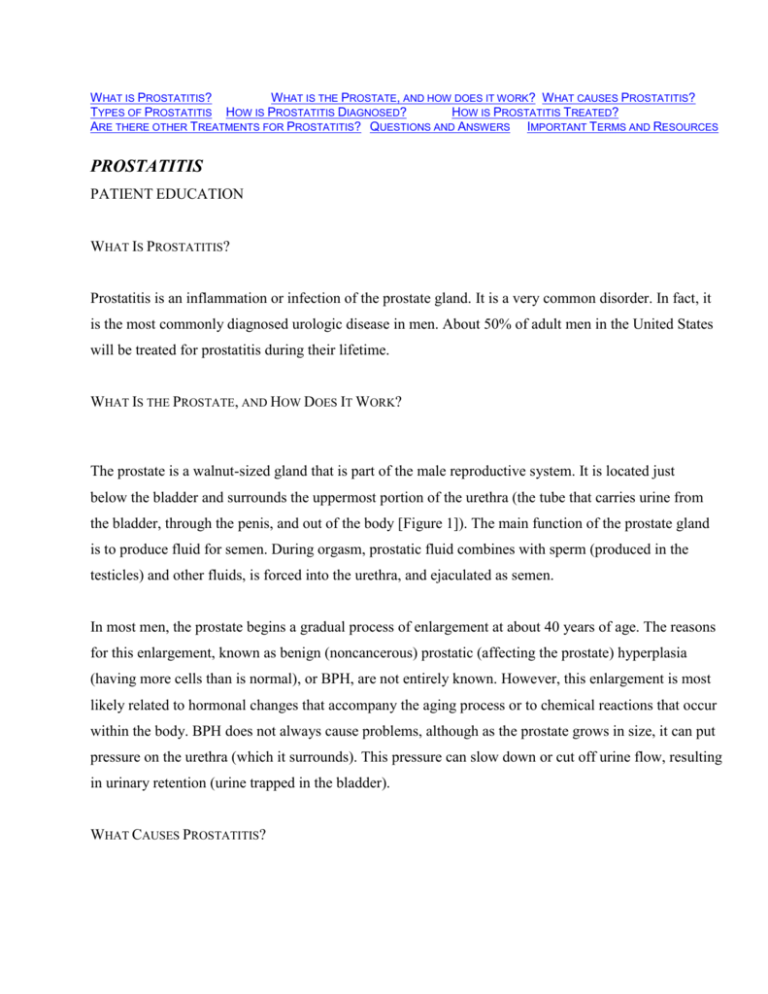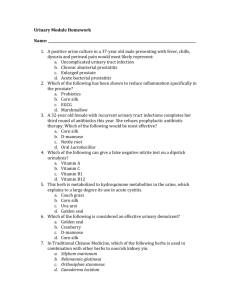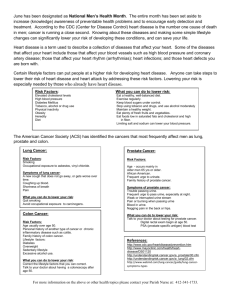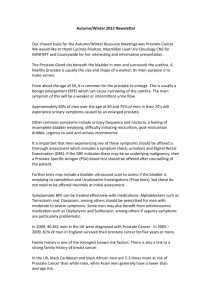
W HAT IS PROSTATITIS?
W HAT IS THE PROSTATE, AND HOW DOES IT WORK? W HAT CAUSES PROSTATITIS?
TYPES OF PROSTATITIS HOW IS PROSTATITIS DIAGNOSED?
HOW IS PROSTATITIS TREATED?
ARE THERE OTHER TREATMENTS FOR PROSTATITIS? QUESTIONS AND ANSWERS IMPORTANT TERMS AND RESOURCES
PROSTATITIS
PATIENT EDUCATION
WHAT IS PROSTATITIS?
Prostatitis is an inflammation or infection of the prostate gland. It is a very common disorder. In fact, it
is the most commonly diagnosed urologic disease in men. About 50% of adult men in the United States
will be treated for prostatitis during their lifetime.
WHAT IS THE PROSTATE, AND HOW DOES IT WORK?
The prostate is a walnut-sized gland that is part of the male reproductive system. It is located just
below the bladder and surrounds the uppermost portion of the urethra (the tube that carries urine from
the bladder, through the penis, and out of the body [Figure 1]). The main function of the prostate gland
is to produce fluid for semen. During orgasm, prostatic fluid combines with sperm (produced in the
testicles) and other fluids, is forced into the urethra, and ejaculated as semen.
In most men, the prostate begins a gradual process of enlargement at about 40 years of age. The reasons
for this enlargement, known as benign (noncancerous) prostatic (affecting the prostate) hyperplasia
(having more cells than is normal), or BPH, are not entirely known. However, this enlargement is most
likely related to hormonal changes that accompany the aging process or to chemical reactions that occur
within the body. BPH does not always cause problems, although as the prostate grows in size, it can put
pressure on the urethra (which it surrounds). This pressure can slow down or cut off urine flow, resulting
in urinary retention (urine trapped in the bladder).
WHAT CAUSES PROSTATITIS?
Infections by bacteria or other organisms cause prostatic inflammation in 50%–70% of men. These
bacteria usually come from a bladder infection. However, they also may come from sexual contact with
a partner who is infected with a sexually transmitted disease. Using condoms during sexual intercourse
may prevent exposure to infection.
Another cause of prostatitis is inflammation caused by a chemical reaction caused by BPH. For
example, if urine flow is slowed down or cut off by BPH, some urine may remain in the urethra after
urination and back up into the prostate gland. This condition is known as urinary reflux. A chemical in
the urine known as urate can then irritate tissues of the prostate gland and cause inflammation.
WHAT CAUSES PROSTATITIS?
In addition to urinary reflux, there are several other ways an infecting organism or irritating chemical
can reach the prostate gland. These include descending from the kidney or bladder or ascending from
seminal vesicles (tubelike structures in the testicles that carry sperm to the part of the urethra surrounded
by the prostate).
Men at increased risk for bacterial prostatitis generally have:
•
Had a recent or recurrent bladder infection
•
BPH
•
Recently had a medical instrument inserted into the urinary tract
•
Engaged in anal intercourse
•
Abnormalities in the urinary tract
TYPES OF PROSTATITIS
There are three major types of prostatitis:
•
Bacterial prostatitis
•
Nonbacterial prostatitis
•
Prostatodynia
Bacterial prostatitis can appear as either acute or chronic. The acute form occurs in about 1 in 10 men
with prostatitis and develops suddenly. Some bacteria that can cause acute bacterial prostatitis are E coli,
Klebsiella, and Pseudomonas.
Symptoms of acute bacterial prostatitis are often severe, and therefore are usually quickly diagnosed.
These symptoms include:
•
Fever
•
Aching muscles
•
Chills
•
Fatigue
•
Pain in lower back
•
Frequent or painful urination
TYPES OF PROSTATITIS
Chronic bacterial prostatitis also occurs in about 1 in 10 men with an infected prostate. Since chronic
means recurrent, this form of bacterial prostatitis keeps returning after the initial infection has been
treated and symptoms disappear.
Nonbacterial prostatitis occurs in about 6 out of 10 men with this infection. Although the causes are
unknown, the inflammation may be related to organisms other than bacteria. For example, men with a
history of allergies and asthma sometimes develop nonbacterial prostatitis. However, doctors cannot be
sure exactly how these conditions are related. Doctors do know that nonbacterial prostatitis is not found
in men with recurrent bladder infections.
Symptoms include:
•
Occasional vague discomfort in the testicles, urethra, lower abdomen, and back
•
Discharge from the urethra, especially during first bowel movement of the day
•
Blood or urine in ejaculate
•
Low sperm count
•
Sexual difficulties
•
Frequent urination
Prostatodynia (pain in the area of the prostate gland) occurs in about 3 out of 10 men with prostate
irritation. Unfortunately, tests used to diagnose infection and other problems affecting the prostate gland
are not useful in detecting the cause of this pain. In some instances, the pain may be caused by a muscle
spasm (an involuntary sudden movement or contraction) at the neck of the bladder or the urethra.
However, usually the cause of prostatodynia is unknown. Symptoms include pain and discomfort in the
prostate gland, testicles, penis, and urethra, and difficulty in urinating.
HOW IS PROSTATITIS DIAGNOSED?
Digital Rectal Exam (DRE)
The DRE is a useful and important tool in the diagnosis of prostatitis. During this exam, your doctor will
examine your prostate by inserting a gloved finger into the rectum. This quick, simple procedure will
reveal the size, shape, and texture of your prostate. It will also identify if the prostate is soft or hard,
bumpy or smooth, warm, or tender. In addition, based on the DRE, your doctor will decide if more tests
are necessary.
Prostate Massage
During the DRE, your doctor will massage the prostate gland to expel fluid from the prostate into the
urethra. The fluid will then be examined for signs of infection.
Sequential Urine Test
This test can help determine the location of an infection. You will be asked to provide three urine
samples: a measured sample of urine, a second sample of any discharge that results from a prostate
massage, and a final sample of urine remaining in the bladder following the prostate massage. The first
sample washes bacteria from the urethra, the second contains prostatic fluid, and the third includes
bacteria in the prostate.
Needle Biopsy
A relatively painless procedure, needle biopsy can be done in your doctor’s office. A long, thin needle is
inserted into the prostate gland to collect small samples of tissue from the prostate. These samples are
then examined by your doctor for infection and abnormal cells. A needle biopsy usually is performed to
diagnose prostate cancer.
HOW IS PROSTATITIS DIAGNOSED?
Prostate-Specific Antigen (PSA)
A simple blood test is used to measure the PSA (a substance produced by the prostate) levels. When
the prostate gland is inflamed, it may produce high levels of PSA, indicating the possibility of
prostatitis. A PSA reading can help your doctor decide what other tests may be needed.
Imaging Tests
The technologies used to produce images of the prostate include:
•
Ultrasound—an image created by sound waves
•
X-rays—taken after a dye is injected into the blood
•
Magnetic resonance imaging (MRI)—produces images of the soft tissues of the body
•
Computerized axial tomography (CAT) scans—also produce images of the soft tissues
of the body
Your doctor will discuss these tests with you in detail if you both agree that more testing is needed.
HOW IS PROSTATITIS TREATED?
Acute Bacterial Prostatitis
Your doctor may prescribe an antibiotic that can penetrate the prostate gland tissues and kill the
bacteria causing the infection. It is important to finish all of the antibiotic to treat the infection.
Chronic Bacterial Prostatitis
Antibiotics are also used to treat this infection, but you should be aware that a chronic infection is
difficult to cure. Longer treatment with antibiotics or different types of medication may be required to
cure the infection.
Nonbacterial Prostatitis
Depending on the cause of the irritation, different treatments may be used. If there is an infection caused
by a nonbacterial organism (for example, a fungal infection), then drugs to kill the fungus may be
prescribed. Ibuprofen may help some patients. If your symptoms are caused by urinary reflux into the
prostate gland, your doctor may prescribe a medicine that helps reduce the amount of irritating
chemicals in the urine.
Thermotherapy (heating the prostate gland with an instrument inserted through the urethra or the
rectum) relieves symptoms in some patients with nonbacterial prostatitis.
Prostatodynia
Your doctor may prescribe medicines that combat urinary problems (such as drugs to prevent muscle
spasms in the bladder and urethra), since these conditions may cause difficult or painful urination.
Thermotherapy may also relieve symptoms.
ARE THERE ANY OTHER TREATMENTS FOR PROSTATITIS?
Medical literature describes many alternative (nondrug) approaches to relieving the symptoms of
prostatitis. Several well-documented therapies are listed below. It is recommended that you speak with
your doctor before starting any alternative therapy.
Heat
Heat therapy comprises warm sitz baths (sitting in a tub of warm water) and hot compresses (not
recommended for patients with acute bacterial prostatitis).
Alternate Hot and Cold Therapy
This form of therapy involves the application of alternating hot and cold compresses to the prostate area.
A hot compress is left in place for 10 minutes and then a cold compress is applied for 10 minutes. This
cycle is then repeated 2 or 3 times daily.
Zinc Supplement
Zinc is an important part of the prostate gland’s defense against infection. A lack of zinc has been
associated with BPH. In addition, some studies show that zinc helps reduce the swelling resulting from
chronic prostatitis.
Anxiety Treatment
Antianxiety medication and nondrug stress relief (such as meditation, biofeedback, and yoga) may help
some people. Regular moderate exercise is also a good way to reduce stress.
Questions and Answers
What kind of doctor should I see if I am having urinary problems or pain in my pelvic area?
You should see your family physician or internist first.
He or she can examine the prostate and test your blood and urine for infection. You may then be referred
to a urologist. A urologist is a doctor who specializes in the diagnosis and treatment of urinary tract
problems, including diseases of the prostate.
Will the prostate exam be painful or embarrassing?
While no one enjoys a prostate exam, it is a relatively simple and painless procedure. It is important to
get a prostate exam if you are a male 40 years of age or older.
If I have an enlarged prostate or prostatitis, does that mean I have cancer?
An enlarged prostate is a common condition in men.
It is noncancerous, and it does not lead to cancer. Prostatitis is an infection of the prostate that can be
caused by bacteria or unknown factors. While prostatitis and cancer can exist at the same time, often
prostatitis can be treated with medication.
Can I infect a sexual partner if I have prostatitis?
It is possible to infect a sexual partner. Prostatitis is not a contagious infectious disease, however,
bacteria contained in semen could be transmitted to your partner during sexual intercourse.
Important Terms and Resources
Acute: sudden and/or severe onset of a condition.
Benign prostatic hyperplasia (BPH): noncancerous enlargement of the prostate gland.
Chronic: recurrent or ongoing condition.
DRE: digital rectal exam; used to feel the size, shape, and texture of the prostate.
PSA: prostate-specific antigen; a blood test is used to help find or follow prostate cancer by measuring
PSA levels.
Prostatitis: an inflammation or infection of the prostate gland.
Prostatodynia: pain that appears to originate in the area of the prostate gland.
Urethra: the channel for both urine and semen, leading from the bladder through the prostate and penis.
Resources
Books
Fox A, Fox B. The Healthy Prostate: A Doctor’s Comprehensive Program for Preventing and Treating
Common Problems. NY: John Wiley & Sons, Inc; 1996.
Rous S. The Prostate Book: Sound Advice on Symptoms and Treatment. NY: WW Norton & Co; 1994.
Walsh, P. The Prostate: A Guide for Men and the Women Who Love Them. Baltimore, Md: Johns
Hopkins University Press; 1995.
Organizations
American Foundation for Urologic Disease, Inc.
1128 North Charles Street
Baltimore, Maryland 21201
1-800-242-2383
www.afud.org
Please check the appropriate boxes that correspond to issues you would like to discuss with your doctor.
Detach and return the completed form to your doctor.
Prostate function
Prostate enlargement
Symptoms
•
Painful, difficult, or frequent urination
•
Pain in the area of the prostate or testicles
•
Fever, chills, sweats
•
Unusual discharge from the urethra
•
Blood in the urine or semen
•
Abdominal or lower back discomfort
Diagnostic tests
•
Digital Rectal Exam (DRE)
•
Prostate-Specific Antigen (PSA)
•
Needle biopsy
Treatment options
•
Standard
•
Alternative
Sexual problems
Personal/other
Developed by:
Stacy J. Childs, MD
Culley C. Carson III, MD
Contributors:
Randall B. Meacham, MD
Craig S. Niederberger, MD
Jenelle E. Foote, MD
Arthur Porter, MD
Lindsey Kerr, MD
Martin I. Resnick, MD
Martin A. Koyle, MD
Larry I. Lipshultz, MD
Richard D. Williams, MD
Norman R. Zinner, MD
Jack W. McAninch, MD
Provided as a service by
Reaching out to patients
The information contained herein presents the opinions of the authors, not Bayer Corporation, Pharmaceutical Division or the American Association of
Clinical Urologists, Inc. (AACU). It is intended for use by patients and their health care professionals.
Copyright©1999 Bayer Corporation, Pharmaceutical Division and the AACU.
All rights reserved. No part of this brochure may be reproduced in any form, in whole or in part, without the express written permission of Bayer
Corporation, Pharmaceutical Division.
The AACU logo is used with permission from the American Association of Clinical Urologists, Inc.








